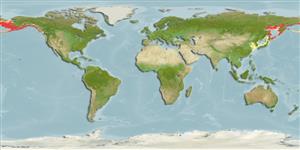Actinopterygii (ray-finned fishes) >
Scorpaeniformes (Scorpionfishes and flatheads) >
Cottidae (Sculpins)
Etymology: Gymnocanthus: Greek, gymnos = naked + Greek, akantha = thorn (Ref. 45335).
Environment / Climate / Range
Ecology
Marine; demersal; depth range 0 - 325 m (Ref. 6793). Temperate, preferred ?
North Pacific: Sea of Japan and the Sea of Okhotsk to the Chukchi Peninsula and Norton Sound, Alaska to Kiska Island in the Aleutian chain and southeastern Alaska.
Size / Weight / Age
Maturity: Lm ? range ? - ? cm
Max length : 28.0 cm TL male/unsexed; (Ref. 56557); common length : 19.5 cm TL male/unsexed; (Ref. 56557); max. published weight: 240.00 g (Ref. 56557); max. reported age: 12 years (Ref. 56557)
Dorsal
spines
(total): 9 - 11;
Dorsal
soft rays
(total): 13-16;
Anal
spines: 0;
Anal
soft rays: 14 - 18. A few bony plates usually present on median line of interorbital space (Ref. 559). Supraocular cirrus absent in adults (Ref. 559). Three pairs of bony tubercles on occiput (Ref. 559). Cleithral spine not developed (Ref. 559). In males, spatulate cirri present on pectoral axil (Ref. 559).
Life cycle and mating behavior
Maturity | Reproduction | Spawning | Eggs | Fecundity | Larvae
Eschmeyer, W.N., E.S. Herald and H. Hammann, 1983. A field guide to Pacific coast fishes of North America. Boston (MA, USA): Houghton Mifflin Company. xii+336 p. (Ref. 2850)
IUCN Red List Status (Ref. 115185)
CITES (Ref. 94142)
Not Evaluated
Threat to humans
Harmless
Human uses
More information
ReferencesAquacultureAquaculture profileStrainsGeneticsAllele frequenciesHeritabilityDiseasesProcessingMass conversion
Tools
Special reports
Download XML
Internet sources
